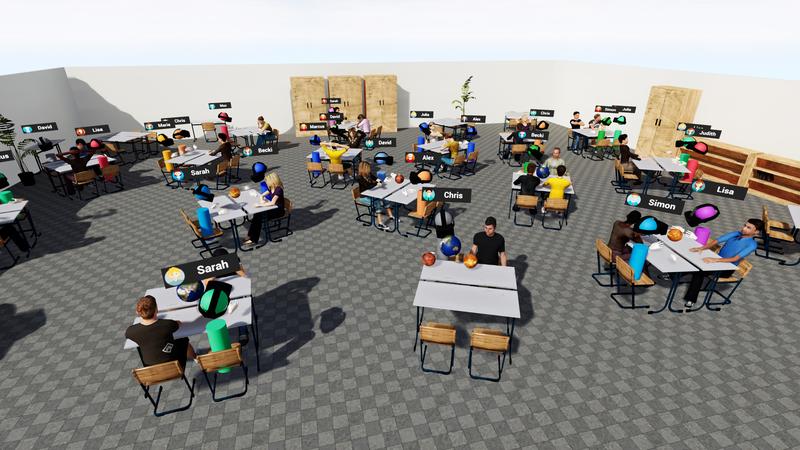
Exploring Virtual Learning: Würzburg’s ViLeArn Initiative

The design of the seminar room on the social VR platform ViLeArn, which is being developed at the University of Würzburg.
ViLeArn / University of Wuerzburg
Würzburg students of teacher training who like to try something new can look forward to the coming semesters. They will have the chance to try-out ViLeArn, a recently developed social-VR platform targeting virtual embodied teaching, during one of their seminars.
ViLeArn allows students to dive into fully equipped virtual teaching environments of flexible layouts which give ample room for various teaching scenarios to try out novel teaching approaches together. The topic of the seminar itself is a perfect fit: It promotes competences in digital media.
Experience Virtual Reality (VR) together: This is called “social VR” and it currently is a hot topic discussed, developed and researched in various contexts, from working life to the leisure and entertainment sector. People put on VR glasses to remotely work together on designs and engines, to train themselves or to support others in difficult operations, or to meet via the Internet to chat in virtual cafés or share adventures in fantastic game worlds and many more.
Embodiment is of paramount importance here. Participants slip into their own personal avatar, whose appearance they can design according to their preferences. The avatars enable us to use all the non-verbal communication signals, our real-world face-to-face encounters heavily depend on and which also are crucial in learning and teaching.
At the same time, the flexibility and freedom of choice of our virtual appearance avoids stigmatization and fosters participation, independent from the real-world whereabouts, thanks to the digital realm and ViLeArn’s internet-enabled distribution.
Can Social-VR also be used successfully in education? Can joint learning work in a Virtual Reality? Professor Silke Grafe (School Pedagogy) and Professor Marc Erich Latoschik (Human-Computer Interaction) from Julius-Maximilians-Universität (JMU) Würzburg in Bavaria, Germany, want to answer these fundamental questions together with their students.
The JMU professors receive a funding of 1.5 million euros for their project “Virtual situated learning and teaching with avatars and agents in social cyberspace”, ViLeArn for short, from the Federal Ministry of Education and Research (BMBF).
Experienced in VR platforms
Grafe and Latoschik have a lot of experience in VR: their teams have already jointly developed and tested the VR-platform “Breaking Bad Behavior”. It is also part of a seminar in which students of teacher training learn how to manage the behavior of a school class.
The students slip into the role of a teacher and approach computer-controlled pupils in a virtual classroom. Immersed in this class simulation, the students are confronted with behaviors known to be detrimental in a teaching environment, from missing attention to various disturbances. This simulation is used to test and train the class leadership skills promoted in the seminar.
“Breaking Bad Behavior” is regularly used at JMU and is very popular among students. The University of Regensburg also has started to try-out the platform “and we continue to receive many enquiries to also use the system, including from abroad,” says Silke Grafe.
Four PhD students take part in developping ViLeArn
ViLeArn is the team’s new endeavor to explore the chances and opportunities of VR-enhanced teaching. A prototype for this novel social-VR system will be ready soon and the team is very much looking forward to let students work with it for the first time.
Four doctoral students are involved in the project: Gabriela Greger and Jennifer Tiede are doing their doctoral theses under Professor Grafe at the Chair of School Pedagogy, Florian Kern and Peter Kullmann are under Professor Latoschik at the Chair of Human-Computer Interaction.
This pioneering work, which is co-financed by the BMBF until the spring of 2022, has plenty of scientific questions to answer. This starts with the appearance of the avatars:
Does it make sense to make the virtual representatives of the students photorealistic? Or is it better to use generic or other abstract bodies because some students might feel and perform better with them? How should the virtual learning environment be laid-out and furnished so that joint learning is successful? How do students react when they have to read and study text in VR? “This, for example, is a real technical challenge, because text still looks very pixelated in VR, which makes it difficult to read,” explains Latoschik. In addition to all these questions, there are many others that need to be clarified.
Establishing VR in university teaching
Grafe and Latoschik are not only interested in Social-VR for scientific reasons. With ViLeArn, they also want to offer students a modern form of education. In addition, there is a learning effect that should be useful for the prospective teachers: They are sensitised to the opportunities but also potential problems that can arise for children and young people who spend their time in virtual realities.
Marc Erich Latoschik is responsible for the e-learning strategy within the framework of the Quality Pact for Teaching at JMU. He can well imagine that platforms like ViLeArn might be useful as a future tool for novel e-learning approaches, e.g., for blended learning scenarios, which rely on a mixture of classical and electronic learning methods. Silke Grafe also does not think that this project will herald the end of classical classroom teaching: “In my opinion, personal encounters in teaching cannot be replaced. But VR-based solutions are a promising supplement for many teaching purposes. “And also the students see this as enrichment”, so their experience.
Prof. Dr. Marc Erich Latoschik, T +49 931 31-85871, marc.latoschik@uni-wuerzburg.de
Prof. Dr. Silke Grafe, T +49 931 31-81535, silke.grafe@uni-wuerzburg.de
https://vilearn.hci.uni-wuerzburg.de/en/about Info and videos about the BMBF project ViLeArn












